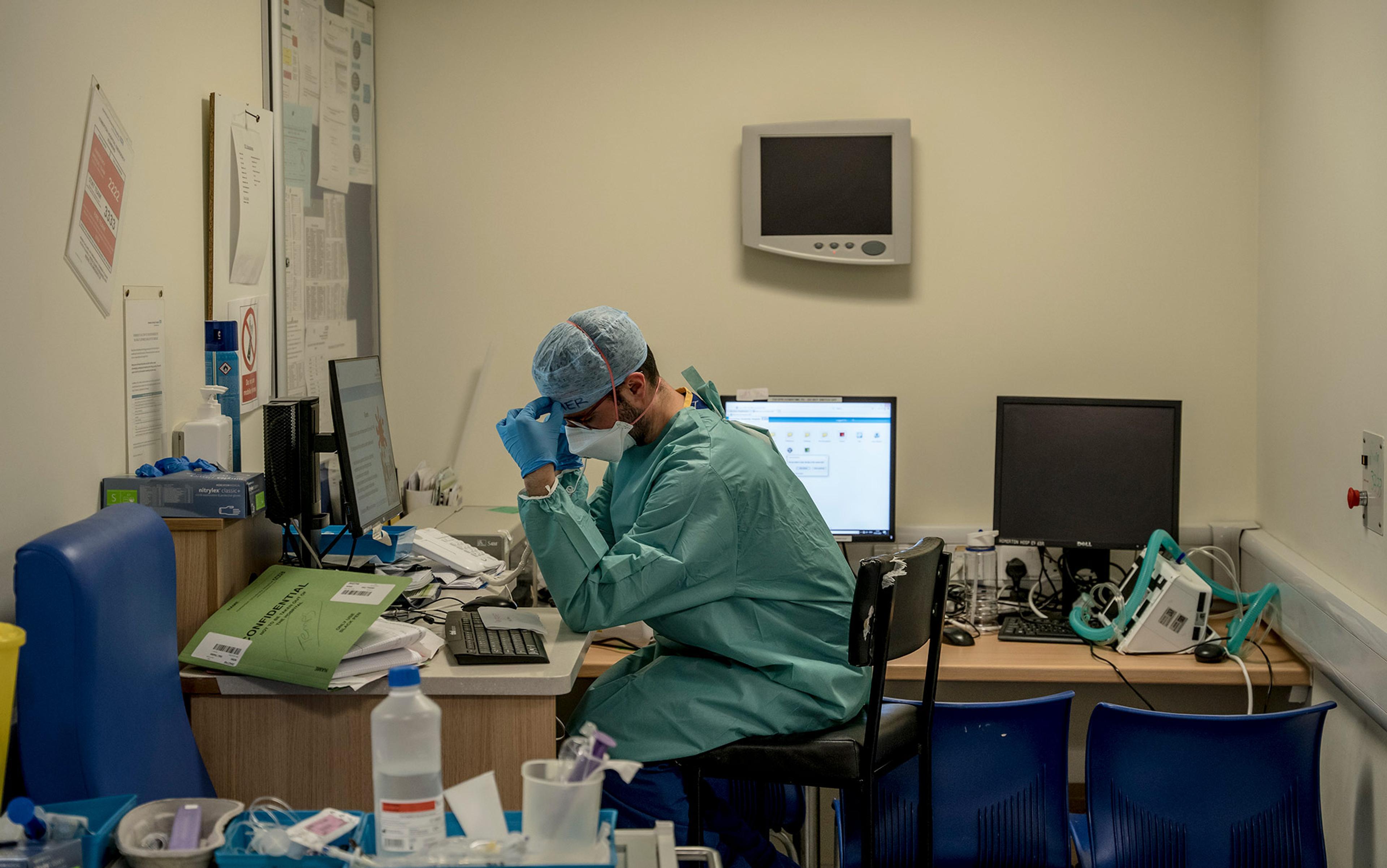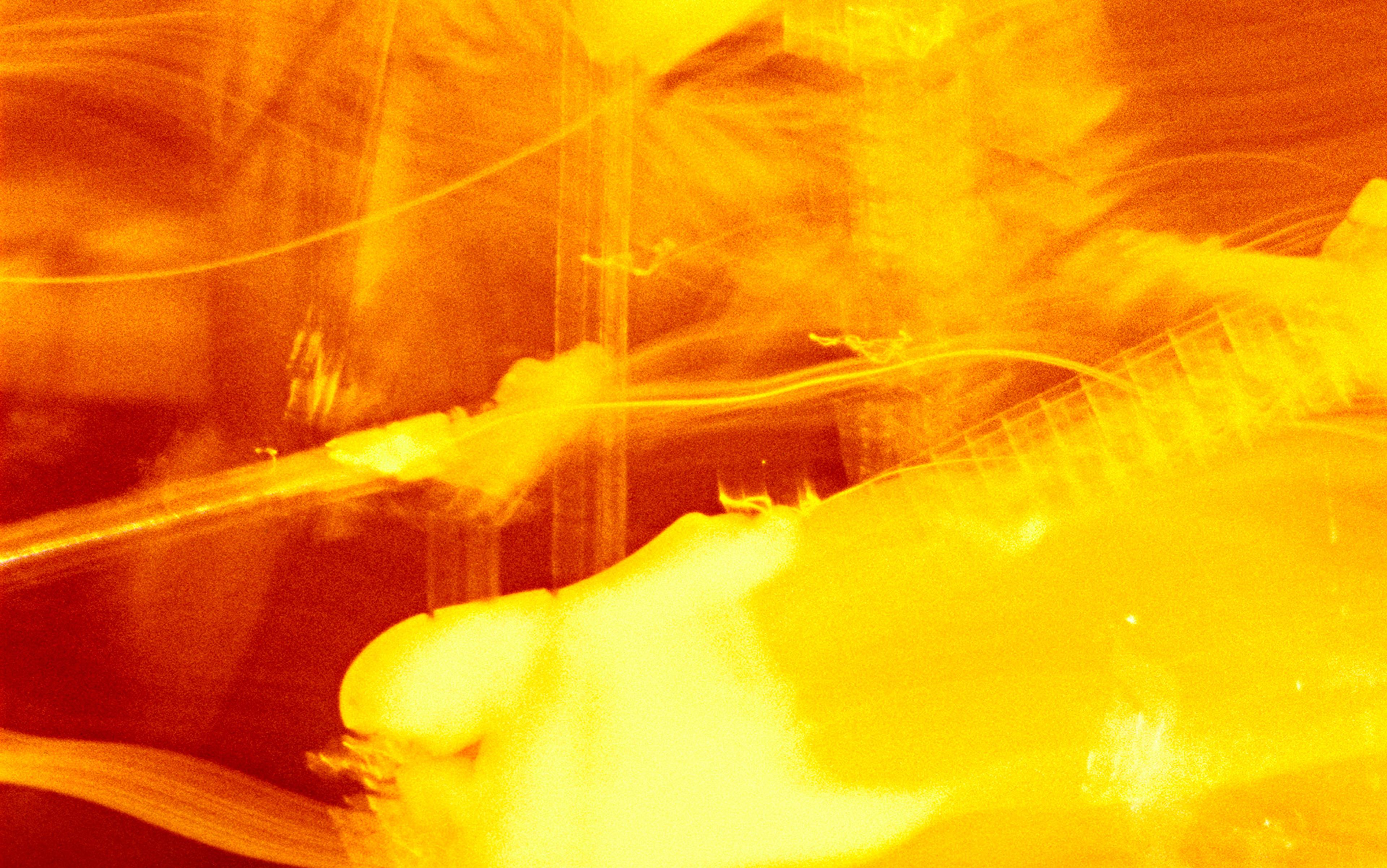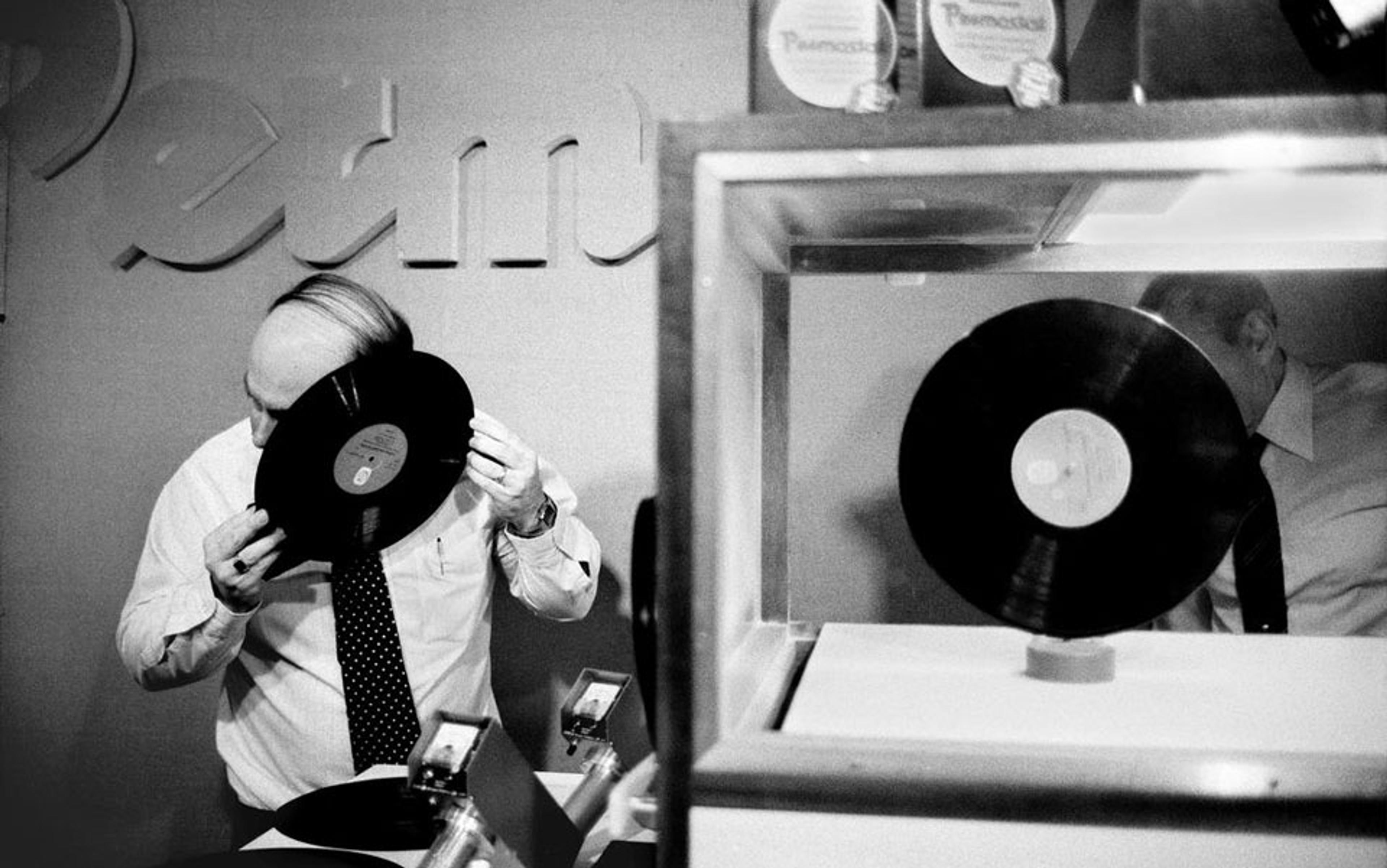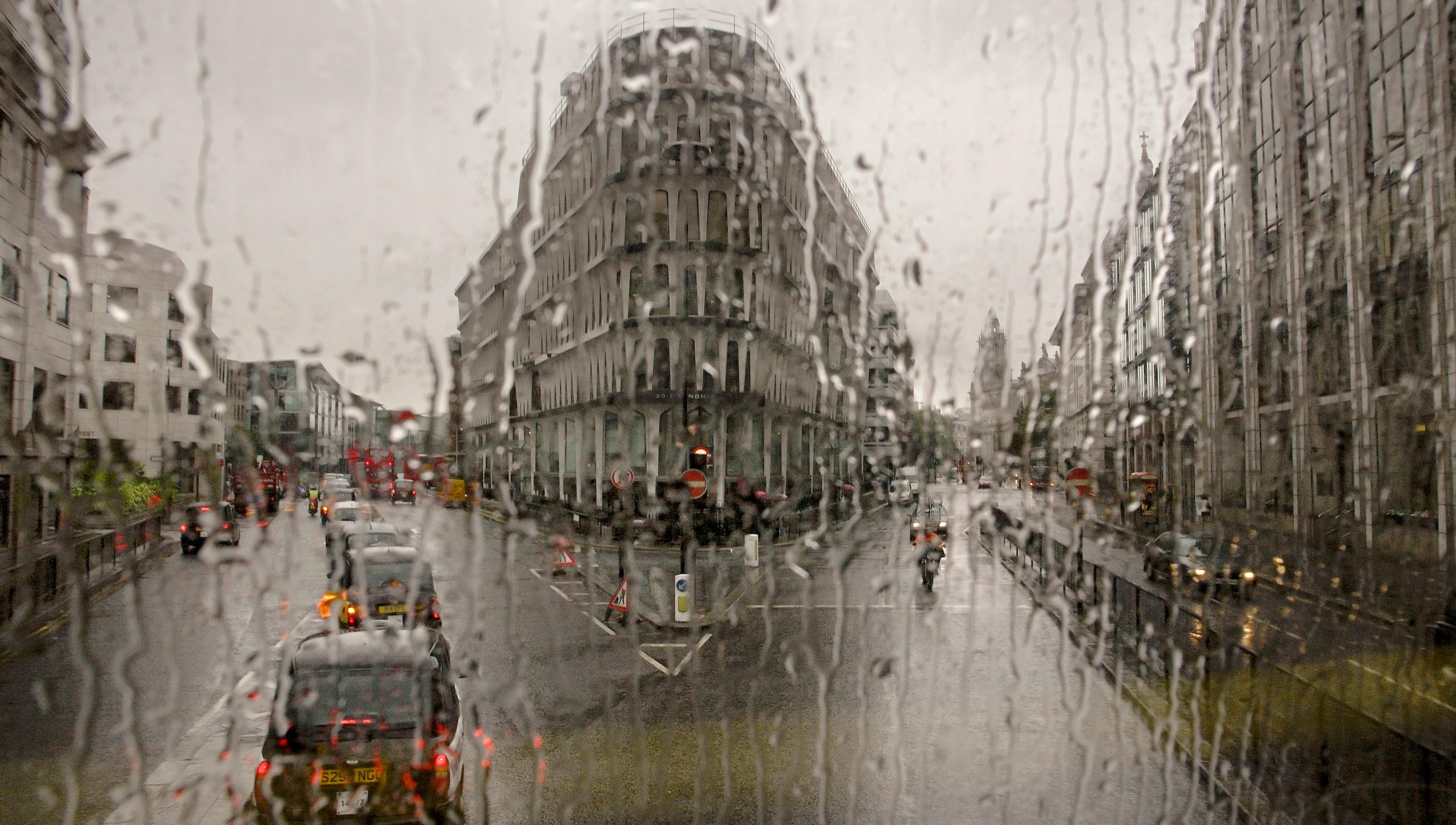It’s an odd gig, even for musicians who are used to some odd venues. For one thing, we can’t see our audience. It’s not that we haven’t attracted many people, so much as that our listeners are in another building. They are lying in hospital beds next door, and they are connected up to machines. Some of them are quite close to death. They are listening – those who have chosen to – on iPads linked to the ward’s WiFi, which is transmitting our live audio stream. Although the music is being broadcast on the internet, it is intended only for one group of people: the patients, carers and staff of the Critical Care Unit at University College Hospital, London (UCH).
The invitations promise ‘a performance of ambient and electronic music’. We had them printed up on good-quality card, and spent half an hour tucking them into cheerful lime-green envelopes. My colleague Nina and I went round the ward earlier, asking those patients who were awake if they wanted to listen, and handing out brand-new headphones and carefully sterilised iPads. The concert has been trailed for several months, but some of the staff need reminders of what is going on. There are emergencies unfolding everywhere. An intensive care unit (ICU), I am learning, is a lively mix of high-tech medicine and the shouty dynamics of a trading floor. We know that the success of our art project is way down the list of priorities.
Darkroom, with Peter Chilvers and Charles Fernyhough, performing for patients and staff of the Critical Care Unit at University College London Hospital, May 2016.
The concert is slated to start at 1pm. At 12:59 some of us are still stuck in the basement of the Wellcome Trust, across the road from the hospital, trying to find a lift big enough to shift a cart of music gear up to the fifth floor. It’s all a bit Spinal Tap. Thankfully, Peter is already plugged in upstairs, and he starts the show with some airy pan drums conjured from his iPad. The rest of us are drilled in setting up quickly, and we are soon wrapping other sounds around his reflective beats. There are guitars, a sax, a flute, a bass clarinet and Os’s modular synth, with cables and switchboard like an old-fashioned telephone exchange. We’re making enough noise to be heard on the adjoining floors, and yet, if we move towards each other, we can still talk while we’re playing. Our audience can’t hear that. Despite stringent tests of the technology, we don’t actually know if anyone can hear anything. All that matters, really, is that we’re doing it. For a couple of hours on a wet Tuesday afternoon, we are putting something out there that is not just about keeping some very sick people alive. It is trivial, ephemeral, vanished into air, but for the moment it feels like the most important thing we could be doing.
Intensive care is no place for the faint-hearted. Improvements in medical technology, particularly the development of the modern positive pressure ventilator, have transformed our efforts at the boundary between life and death. A few decades ago, many of the people in that ward next door would already be dead.
But progress comes at a cost. The noise of life-support machines and vital-sign monitors is a constant background. Phones ring, bin lids bang, staff call for help and doctors are constantly being paged to the next emergency. The racket frequently exceeds World Health Organisation (WHO) guidelines for safe noise levels. In The Guardian in 2016, Helen Taylor, an intensive care survivor, described a ‘constant, frightening’ noise from which there was little respite at night. It’s one reason why a recent article likened the modern ICU to ‘a branch of hell’.
The chaotic atmosphere was less of a problem 10 years ago. If I had stepped next door then, there would have been few patients awake to disturb. The standard approach, while life-saving procedures were being administered, was heavy sedation. While the machine was being fixed, the patient was put into a coma.
That changed with the recognition that, inside those ravaged, intubated bodies, minds were still working. And those minds were not at ease. The British journalist David Aaronovitch had a stint in intensive care after routine keyhole surgery went disastrously wrong. He heard people behind a curtain railing violently against him. As his disorientation deepened, he started to believe that the sinister officers of the night shift were preparing his body for human consumption. They were feeding him oxygen in order to make his flesh sweeter. He was going to be eaten.
This kind of break with reality used to be known as ICU psychosis. Nowadays, the term ‘delirium’ has superseded it, particularly when there is an apparent biological cause such as medication, inflammation or sepsis. In delirium, the patient’s attention is disrupted and vivid hallucinations and delusions sweep in. The British artist Victoria Hume, who made a piece based on conversations with ICU survivors, told me she heard stories of ‘persecution, conspiracy and terror – of bombs under the bed, or being left at the bottom of a lift shaft for eternity, or trapped on a spaceship, unable to return home’. In patients who are heavily sedated and on ventilators, rates of ICU delirium are as high as 80 per cent.
For all the worthy intentions, critically ill patients were now coming to their senses in a suburb of hell
Unsurprisingly, such horrors are not easily forgotten. An intensive-care stay can be a psychological and physical trauma; invaded on all sides, the body feels like it is being murdered. The mind reacts accordingly. The condition of post-traumatic stress disorder (PTSD) is defined in terms of re-experiencing the horror (through flashbacks) of the original trauma, avoidance of trauma-related situations, numbing of general responsiveness, and hyperarousal. A recent study showed that a quarter of ICU patients with a particular life-threatening respiratory condition had signs of PTSD six months after discharge. In this study, you were pretty much as likely to suffer from PTSD after an ICU stay as you are if you have been raped or have fought in a war.
The evidence points to sedation as the culprit. Originally intended to ease the discomfort caused by ventilator intubation, sedation also reduced the risk that confused patients would thrash around and dislodge their tubing. Strong pharmacological agents, particularly benzodiazepines, had the unintended consequence of causing psychotic breaks, which in turn led to trauma reactions.
Good reason, then, for reversing the policy of heavy sedation. But, for all the worthy intentions, critically ill patients were now coming to their senses in a suburb of hell. The former patient Taylor noted the horrible irony that her hearing was pretty much the only one of her senses that was preserved. That wide-awake patient might now be all ears, but tubes, masks and general incapacity can make it difficult to communicate. What’s more, hospital infrastructures have generally not kept up with the change in sedation policy. Most modern units were equipped in the era when critical patients were kept comatose; as a result, there probably seemed little point in putting in expensive entertainment systems. That’s certainly the case in the ward at UCH. The unit has WiFi, and there are some iPads for patients to use. Otherwise, there isn’t a whole lot for patients to do except listen to the machines and ruminate on what is happening to them. Life-saving is the order of the day, and there is often little time in the busy schedule of the unit to think about the patients’ experiences as people.
‘A performance of ambient and electronic music.’ It seems odd to be taking part in an art project in the part of my life I spend doing academic research. As a psychologist with ambitions to find better ways to understand human experience, I have a professional interest in the long history of how art has been used to improve hospital environments – and the psychological mechanisms that might lie behind its effects. In her book Notes on Nursing (1859), Florence Nightingale wrote of patients’ need for diversity in their sensory surroundings. ‘The effect in sickness of beautiful objects, of variety of objects, and especially of brilliancy of colour, is hardly at all appreciated … People say the effect is only on the mind. It is no such thing. The effect is on the body, too.’
Evidence-based design in clinical environments arguably began with a 1984 article by the architecture scholar Roger Ulrich, then at the University of Texas, which showed that simply having a view through a window improved rates of recovery from surgery. The idea is that a more pleasant milieu reduces patient stress, which in turn has an influence on clinical outcomes. When the researcher Daisy Fancourt at the Royal College of Music led a consultation on intensive care practices, she realised that ease of patient monitoring came at a human cost. ‘We found that the beds often face away from windows,’ she told me, ‘and as a result patients can lose their diurnal cycle because they’re not actually getting proper daylight.’ In one project, bone marrow transplant patients were set up with TVs live-streaming views of nature, with patients able to control where the cameras were set. That might have benefited Aaronovitch, who also had a window out of sight behind him. ‘I had no idea whether it was night or day,’ he told me, ‘no idea who anyone was. I had no clues to the outside world.’
Music has begun to emerge as a specifically powerful therapeutic medium. In the late Victorian era, the choir of the Guild of St Cecilia played among the resonant plumbing of London hospital basements, bringing (literally) piped music to scarlet fever patients in the wards above. Recent research has shown that listening to music can reduce levels of the stress hormone cortisol (one of Fancourt’s studies found the effect as a result of attending a live concert). In terms of therapeutic mechanisms, we are in the realm of educated guesses rather than hard science, but there is enough out there to persuade people to take music seriously as a clinical tool.
A problem is that one person’s easy listening is another’s aural poison. That’s a reason for thinking that music might be particularly useful when it is not aimed at the centre of the listener’s attention. In many respects, ambient music takes the default settings of pop music and flips all the switches the other way. Instead of distinctive rhythms, it gives us shifting periodicities. The melodies of pop command the attention, and we want our ambient performance to be there and yet not there at the same time. In the words of its greatest modern pioneer, Brian Eno, ‘ambient music must be able to accommodate many levels of listening attention without enforcing one in particular; it must be as ignorable as it is interesting.’ This is music aimed simultaneously at both the centre and the periphery of experience. It’s about what you don’t play as much as what you do.
It is not music for tapping your foot to. It’s music designed to take you into another mental space
Another thing about ambient music is that it turns down the predictability. In her writing on the effects of noise on patients, Nightingale stressed the importance of the psychological significance of certain sounds. ‘Unnecessary noise, or noise that creates an expectation in the mind, is that which hurts a patient.’ A repeating rhythm can be like a dripping tap: an agonising, predictable annoyance. If you hear one drum beat in a pattern, you are instinctively waiting for the next. Our music is mainly improvised, and thus less likely to get stuck in relentless patterns. It mostly eschews regular beats. Think of those apps you can buy to simulate soothing nature sounds: it’s no accident that they use periodic but non-repeating sounds such as rainfall or waves on a shore. The power of a regular pulse to command attention is one reason why I personally can’t listen to pop music while working: all those seductive beats screw up the rhythm of my thoughts.
Rhythmic unpredictability is only one of the things going on. By not commanding the listener’s attention, ambient music frees the mind to wander. In the sleevenotes to his pioneering Music for Airports (1978), Eno wrote that ambient music ‘is intended to induce calm and a space to think’. It is not music for tapping your foot to. It’s music designed to take you into another mental space.
It’s that potential to set minds wandering that lies behind our art project. Behind the chilled-out purveyor of ambient sounds, there’s an inquiring researcher looking for what might just lead to a clinical development. In my part-time academic post, I research inner experience: everyday phenomena such as mind-wandering, and more unusual mental happenings such as hallucinations. Both of these extremes can be encompassed in the experience of ICU patients, whose bodies can appear to be doing not very much at all, but whose minds are often far from restful. The Wellcome Trust, our venue for today, is the home of Hubbub, an interdisciplinary research project examining the idea of rest and its opposites from perspectives ranging from cultural history to neuroscience. We now know a fair amount about how human brains function in the so-called ‘resting state’, where participants lie in an MRI scanner with no specific instructions to do anything. I have a particular interest in how to map the movements of an unstill mind on to the complex dynamics of a resting brain, particularly the activity of the default mode network: a set of brain areas that activate when a person is not engaged in any specific task.
No one has yet tested Eno’s ideas on how ambient music might promote mind-wandering. There are reasons for thinking that being able to escape the present moment might be particularly valuable in a clinical context. One research team gave participants small electric shocks on their wrists, and then asked whether or not they were focused on the discomfort. Those who reported their minds wandering away from the pain showed greater cognitive focus during the experience of the shock, through recruitment of the default mode network and its engagement with pain-suppression regions in the brain. Although the emphasis was on individual differences in people’s tendency to mind-wander away from pain, they suggest that encouraging mind-wandering might bring clinical benefits.
Perhaps no one has a greater need to escape the present moment than an ICU patient. Led by the psychologist Dorothy Wade, the team at the UCH unit has been pioneering new methods of reducing the stress of the intensive care experience. The approach is preventative rather than reactive. ‘We train nurses in the unit to talk to patients about any worries or fears,’ Wade told me, ‘and to remind them they are in a safe place. We encourage patients to listen to music or relaxation exercises, and to enjoy favourite pastimes such as reading.’ This approach is being trialled in a national study, which involves Aaronovitch as a patient representative. He feels that more needs to be done to educate staff, families and the general public about the problem of ICU delirium, especially given how varied patients’ reactions can be. During his own intensive care stay, staff would tell his family that he was ‘a bit confused’. ‘One thing I was not was confused,’ he told me. ‘I knew exactly what was going on; it just happened to be delusional. “Confusion” as a euphemism for “psychosis” is deeply unhelpful.’
It’s not even the smallest audience I have ever played to. I know that we have handed out a total of six iPads; it might have been more, but the WiFi in one half of the ward is down. I’m not feeling as ethereal as I could be, having dashed to and fro in the rain across Gower Street for much of the morning, shuttling between the two buildings to get things ready. But our tentative start is soon giving way to Mike’s lush guitar textures and swooshy atmospherics from the modular synth. When I was 17 and aspiring to be a heavy-metal axe god, it was all about how many notes I could play to the bar; now, it’s about how few. Some of the best moments are when we all join in with the same drone note for what could be more than a minute. With this music, it’s all about getting into the zone. It would be a lie to say that we are always conscious of what we are doing. If we are drifting away, it’s because we want others to do so too.
Whatever happens here today, no one should take it as evidence for a clinical breakthrough. The rigorous scientific research remains to be done: our efforts are simply a tentative first step. But they might give us a way of thinking differently about how to mitigate the psychological effects of a stay in intensive care. If particular kinds of music can move patients into different mental spaces through the everyday phenomenon of mind-wandering, then the clinical implications could be profound.
It doesn’t really matter whether they love or hate the music. What matters is that they are still here
I watch the signal streaming on my laptop, and think of the patients in the ward next door. When I pitched the idea to Guy Noble, art director for the UCLH trust, I told him we wanted to make ‘a gift of music’. It matters that we are here, taking the time, rather than piping in something that has been pre-recorded. For Fancourt, who has worked with live musicians in hospital wards, the social aspect of this kind of intervention might be all-important. ‘There’s something nice about the fact that it’s bespoke to the patients,’ she told me; ‘that someone’s doing it for them at that moment in time.’
In the end, it’s all about acknowledging the audience as people. For a couple of hours, a few strangers have been treating them as something other than complex problems that need solving with machinery. They can stop listening at any time; while I noodle next door, Nina is checking on them frequently to ensure that they are happy to continue. It doesn’t really matter to us whether they love the music or hate it. What matters is that they are still around to do the loving or hating. They are still here.
At the end of the show, the iPads are programmed to pop up a brief feedback questionnaire. The handful of responses suggest that those who listened found it calming and a bit tranceful. Nina tells me that a couple of patients listened all the way through. ‘Fucking trippy,’ one of them told her, apparently approvingly. I hadn’t expected people to stick with it. At various points in the planning of the past few months, this concert has seemed like an absurd idea. Calling it a gift of music sounds pretentious now. But it’s a gift of something: attention, compassion, an unconditional willingness to acknowledge the fact of someone else’s experience. For those who suffer the trials of intensive care, it is a gift they deserve.






